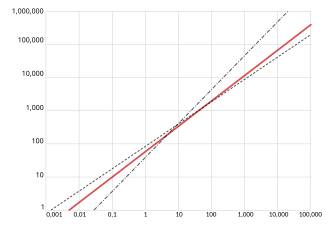Kleiber's law

Kleiber's Law, named after Max Kleiber's pioneering work in the early 20th century, is a key principle in the field of ecology, biology, and biophysics. It describes the relationship between the metabolism of an organism and its body mass. Specifically, Kleiber's Law posits that the metabolic rate scales to the ¾ power of the organism's body mass. This relationship is often summarized by the equation:
\[ \text{Metabolic Rate} = k \times \text{Mass}^{3/4} \]
where \(k\) is a constant that varies among species but is generally similar within broad groups of organisms.
Overview[edit]
Kleiber's Law suggests that larger animals are more efficient in terms of energy use than smaller animals. This scaling law has profound implications for understanding the energy dynamics of living organisms, influencing their growth rates, lifespan, and even ecological interactions. The law applies across a wide range of species, including both endothermic (warm-blooded) and ectothermic (cold-blooded) organisms, although the specific value of \(k\) and the scaling exponent can vary.
Historical Background[edit]
Max Kleiber, a Swiss agricultural chemist, first formulated the law in the 1930s while studying the relationship between body size and metabolic rate in animals. His research was groundbreaking, providing a quantitative basis for the observation that larger animals have slower metabolisms on a per-unit-body-weight basis than smaller animals.
Biological and Ecological Significance[edit]
Kleiber's Law has several important implications in biology and ecology. It helps explain patterns of energy consumption, growth rates, and lifespan across different species. For example, it suggests why larger animals like elephants have longer lifespans and slower growth rates compared to smaller animals like mice. In ecosystems, the law influences how energy flows from one trophic level to another, affecting the structure and dynamics of ecological communities.
Challenges and Criticisms[edit]
While widely accepted, Kleiber's Law is not without its critics. Some researchers argue that the ¾ scaling exponent is not universal and that different exponents might apply in certain conditions or for specific groups of organisms. Additionally, there are debates about the underlying mechanisms that drive this scaling relationship, with theories ranging from resource distribution networks within organisms to constraints imposed by surface area-to-volume ratios.
Conclusion[edit]
Kleiber's Law remains a fundamental concept in the study of metabolic rates, body size, and energy use among organisms. Despite ongoing debates and challenges, it continues to be a cornerstone in the fields of ecology, evolutionary biology, and biophysics, providing insights into the complex interactions between organisms and their environments.

Ad. Transform your life with W8MD's Budget GLP-1 injections from $75


W8MD offers a medical weight loss program to lose weight in Philadelphia. Our physician-supervised medical weight loss provides:
- Weight loss injections in NYC (generic and brand names):
- Zepbound / Mounjaro, Wegovy / Ozempic, Saxenda
- Most insurances accepted or discounted self-pay rates. We will obtain insurance prior authorizations if needed.
- Generic GLP1 weight loss injections from $75 for the starting dose.
- Also offer prescription weight loss medications including Phentermine, Qsymia, Diethylpropion, Contrave etc.
NYC weight loss doctor appointmentsNYC weight loss doctor appointments
Start your NYC weight loss journey today at our NYC medical weight loss and Philadelphia medical weight loss clinics.
- Call 718-946-5500 to lose weight in NYC or for medical weight loss in Philadelphia 215-676-2334.
- Tags:NYC medical weight loss, Philadelphia lose weight Zepbound NYC, Budget GLP1 weight loss injections, Wegovy Philadelphia, Wegovy NYC, Philadelphia medical weight loss, Brookly weight loss and Wegovy NYC
|
WikiMD's Wellness Encyclopedia |
| Let Food Be Thy Medicine Medicine Thy Food - Hippocrates |
Medical Disclaimer: WikiMD is not a substitute for professional medical advice. The information on WikiMD is provided as an information resource only, may be incorrect, outdated or misleading, and is not to be used or relied on for any diagnostic or treatment purposes. Please consult your health care provider before making any healthcare decisions or for guidance about a specific medical condition. WikiMD expressly disclaims responsibility, and shall have no liability, for any damages, loss, injury, or liability whatsoever suffered as a result of your reliance on the information contained in this site. By visiting this site you agree to the foregoing terms and conditions, which may from time to time be changed or supplemented by WikiMD. If you do not agree to the foregoing terms and conditions, you should not enter or use this site. See full disclaimer.
Credits:Most images are courtesy of Wikimedia commons, and templates, categories Wikipedia, licensed under CC BY SA or similar.
Translate this page: - East Asian
中文,
日本,
한국어,
South Asian
हिन्दी,
தமிழ்,
తెలుగు,
Urdu,
ಕನ್ನಡ,
Southeast Asian
Indonesian,
Vietnamese,
Thai,
မြန်မာဘာသာ,
বাংলা
European
español,
Deutsch,
français,
Greek,
português do Brasil,
polski,
română,
русский,
Nederlands,
norsk,
svenska,
suomi,
Italian
Middle Eastern & African
عربى,
Turkish,
Persian,
Hebrew,
Afrikaans,
isiZulu,
Kiswahili,
Other
Bulgarian,
Hungarian,
Czech,
Swedish,
മലയാളം,
मराठी,
ਪੰਜਾਬੀ,
ગુજરાતી,
Portuguese,
Ukrainian